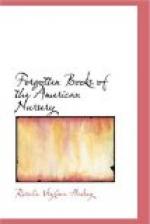“When thus her story she to
them had told,
She said, put me to bed for
I am cold.”
The illustrations of a later edition entered thoroughly into the spirit of the author’s intent. The contemporary opinion of the French character is quaintly shown in the portrait of the Devil dressed as a French gentleman, his cloven foot discovering his identity. Whatever deficiencies are revealed in these early attempts to illustrate, they invariably expressed the artist’s purpose, and in this case the Devil, after the girl’s conversion, is drawn in lines very acceptable to Puritan children’s idea of his personality.
Almanacs also were in demand, and furnished parents and children, in many cases, with their entire library for week-day reading. “Successive numbers hung from a string by the chimney or ranked by years and generations on cupboard shelves."[26-A] But when Franklin made “Poor Richard” an international success, he, by giving short extracts from Swift, Steele, Defoe, and Bacon, accustomed the provincial population, old and young, to something better than the meagre religious fare provided by the colonial press.
Such, then, were the literary conditions for children when an advertisement inserted in the “Weekly Mercury” gave promise of better days for the little Philadelphians.[26-B] Strangely enough, this attempt to make learning seem attractive to children did not appear in the booksellers’ lists; but crowded in between Tandums, Holland Tapes, London Steel, and good Muscavado Sugar,—“Guilt horn books” were advertised by Joseph Sims in 1740 as “for sale on reasonable Terms for Cash.”
[Illustration: The Devil appears as a French Gentleman]
Horn-books in themselves were only too common, and not in the least delightful. Made of thin wood, whereon was placed a printed sheet of paper containing the alphabet and Lord’s Prayer, a horn-book was hardly, properly speaking, a book at all. But when the printed page was covered with yellowish transparent horn, secured to the wooden back by strips of brass, it furnished an economical and practically indestructible elementary text-book for thousands of English-speaking children on both sides of the Atlantic. Sometimes an effort was also made to guard against the inconvenient faculty of children for losing school-books, by attaching a cord, which, passing through a hole in the handle of the board, was hung around the scholar’s neck. But since nothing is proof against the ingenuity of a schoolboy, many were successfully disposed of. Although printed by thousands, few in England or in America have survived the century that has elapsed since they were used. Occasionally, in tearing down an old building, one of these horn-books has been found; dropped in a convenient hole, it has remained secure from parents’ sight, until brought to light by workmen and prized as a curiosity by grown people of the present generation. This notice of little gilt horn-books was inserted in the “Weekly Mercury” but once. Whether the supply was quickly exhausted, or whether they did not prove a successful novelty, can never be known; but at least they herald the approach of the little gilt story-books which ten years later were to make the name of John Newbery well known in English households, and hardly less familiar in the American colonies.




